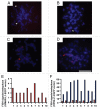An S/MAR-based L1 retrotransposition cassette mediates sustained levels of insertional mutagenesis without suffering from epigenetic silencing of DNA methylation
- PMID: 20595816
- PMCID: PMC3052846
- DOI: 10.4161/epi.5.7.12647
An S/MAR-based L1 retrotransposition cassette mediates sustained levels of insertional mutagenesis without suffering from epigenetic silencing of DNA methylation
Erratum in
- Epigenetics. 2011 Jul;6(7):951
Abstract
L1 is an insertional mutagen that is capable of mediating permanent gene disruption in mammalian genomes. However, currently available L1 retrotransposition vectors exhibit low or unstable transgene expression when expressed in somatic cells and tissues. This restriction limits their potential utility in long-term screening procedures or somatic mutagenesis applications. In this study, we addressed this problem by developing a minicircle, nonviral L1 retrotransposition vector using a scaffold/matrix attachment region (S/MAR) in the vector backbone and evaluated its utility in human cell lines. The S/MAR-based L1 retrotransposition vector provides stable, elevated levels of L1 expression compared to the currently used EBNA1-based L1 vector. In addition, the S/MAR elements effectively mediate sustained levels of L1 retrotransposition in prolonged cell culturing without suffering from epigenetic silencing by DNA methylation or from vector integration problems even in the absence of selection pressure. These findings indicate that the simple inclusion of S/MAR in the vector backbone increased levels of L1 expression and retrotransposition that can be used as an effective tool to generate insertional mutagenesis in large-scale somatic mutagenesis applications in mammalian cells.
Figures




Similar articles
-
Exploiting the power of LINE-1 retrotransposon mutagenesis for identification of genes involved in embryonic stem cell differentiation.Stem Cell Rev Rep. 2014 Jun;10(3):408-16. doi: 10.1007/s12015-014-9500-9. Stem Cell Rev Rep. 2014. PMID: 24610122 Free PMC article.
-
The functional role of S/MARs in episomal vectors as defined by the stress-induced destabilization profile of the vector sequences.J Mol Biol. 2009 Apr 17;387(5):1239-49. doi: 10.1016/j.jmb.2009.02.043. Epub 2009 Feb 25. J Mol Biol. 2009. PMID: 19248788
-
De novo LINE-1 retrotransposition in HepG2 cells preferentially targets gene poor regions of chromosome 13.Genomics. 2014 Aug;104(2):96-104. doi: 10.1016/j.ygeno.2014.07.001. Epub 2014 Jul 17. Genomics. 2014. PMID: 25043885 Free PMC article.
-
Retrotransposon-adenovirus hybrid vectors: efficient delivery and stable integration of transgenes via a two-stage mechanism.Curr Gene Ther. 2004 Dec;4(4):373-84. doi: 10.2174/1566523043346084. Curr Gene Ther. 2004. PMID: 15578988 Review.
-
LINE-1 retrotransposition in the nervous system.Annu Rev Cell Dev Biol. 2012;28:555-73. doi: 10.1146/annurev-cellbio-101011-155822. Annu Rev Cell Dev Biol. 2012. PMID: 23057747 Review.
Cited by
-
Exploiting the power of LINE-1 retrotransposon mutagenesis for identification of genes involved in embryonic stem cell differentiation.Stem Cell Rev Rep. 2014 Jun;10(3):408-16. doi: 10.1007/s12015-014-9500-9. Stem Cell Rev Rep. 2014. PMID: 24610122 Free PMC article.
-
Prognostic value of LINE-1 retrotransposon expression and its subcellular localization in breast cancer.Breast Cancer Res Treat. 2012 Nov;136(1):129-42. doi: 10.1007/s10549-012-2246-7. Epub 2012 Sep 29. Breast Cancer Res Treat. 2012. PMID: 23053642 Free PMC article.
References
Publication types
MeSH terms
Substances
LinkOut - more resources
Full Text Sources
Other Literature Sources
